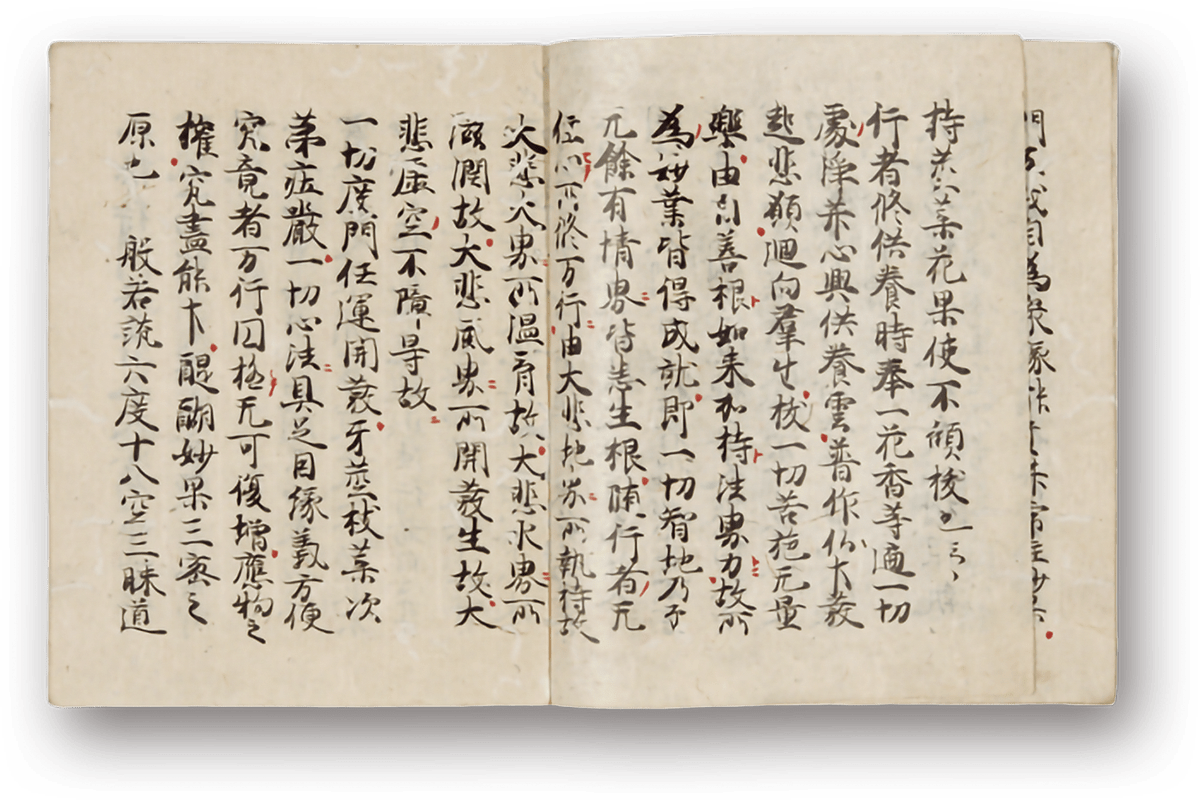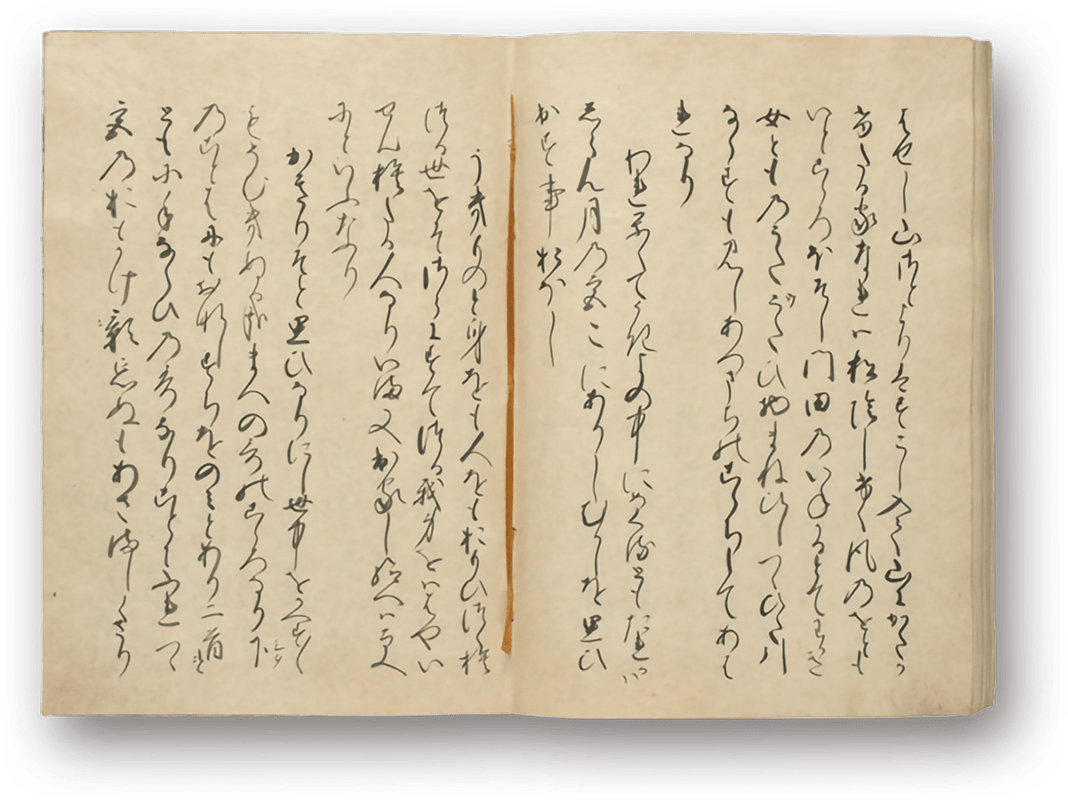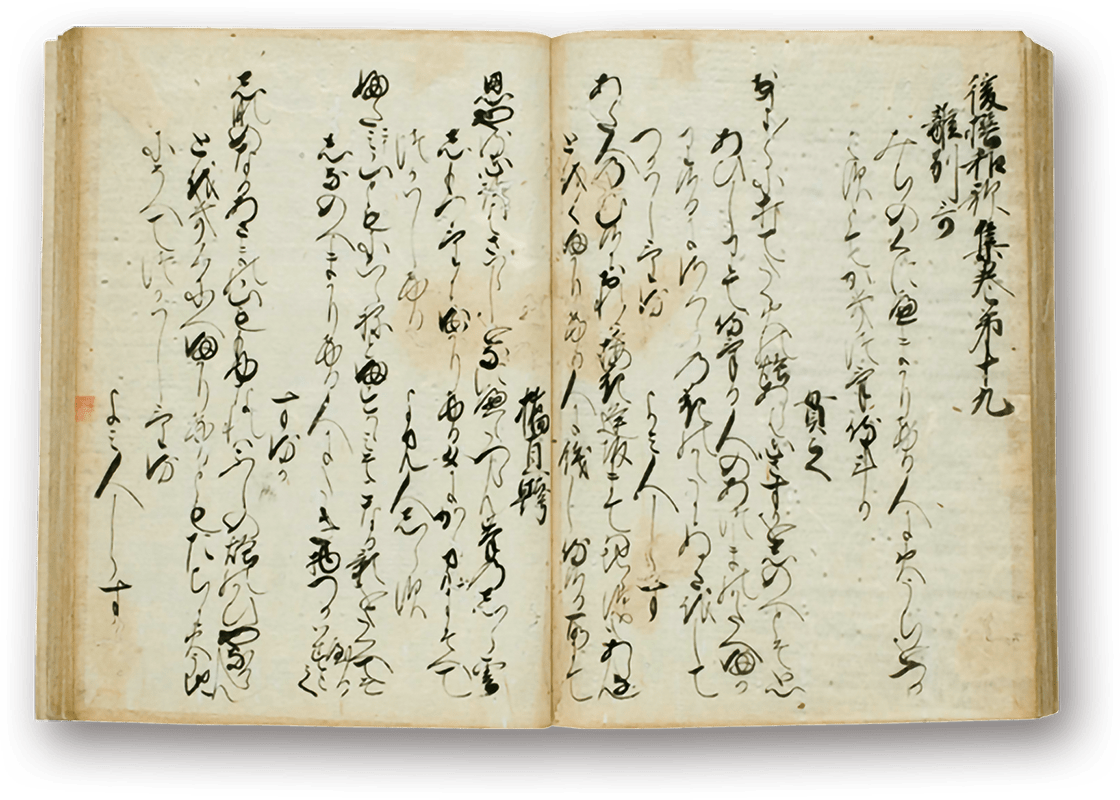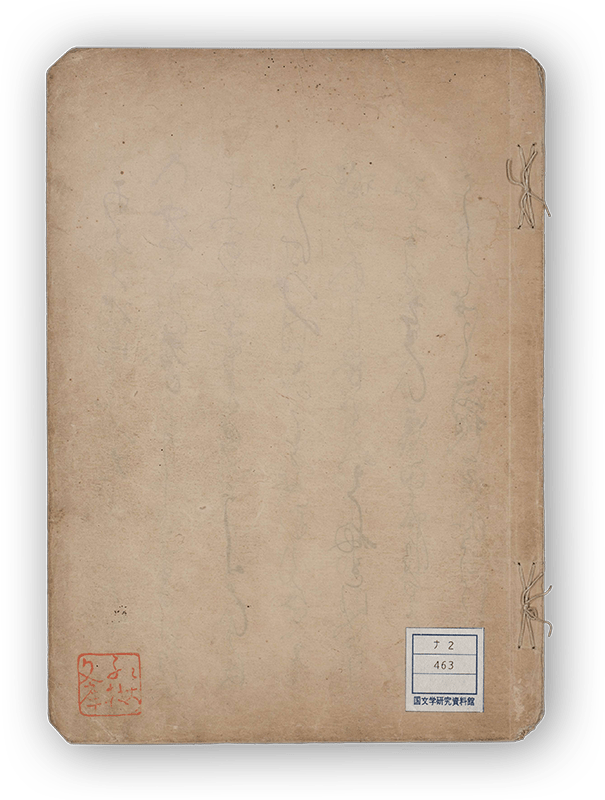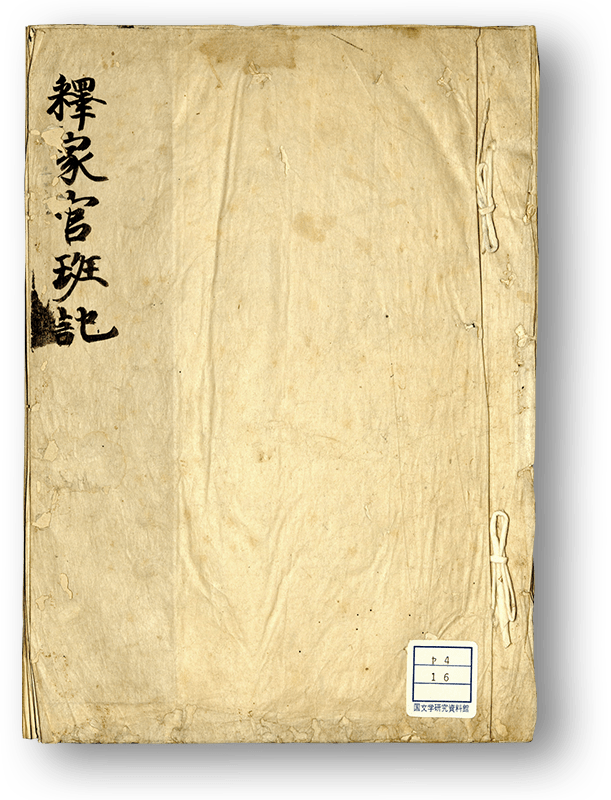Binding of Japanese Books - 和書の装訂
Simply put, binding means how paper is used to make a single copy of a book, broadly categorized into groups of kansubon, orihon, and sasshibon in terms of its form.装訂とは、簡単に言えば紙をどのように使って一つの本を作るかということで、形状から、大きく巻子本の類・折本の類・冊子本の類に分けることができます。
Kansubon Group - 巻子本の類
Binding by splicing pieces of paper horizontally and rolling them. Kansubon and tsugigami fall in this category.紙を横に貼り継いで行き、丸く巻いた装訂で、巻子本と継紙がこれに当たります。
Kansubon Group - 巻子本の類
Kansubon - 巻子本
Binding by joining pieces of paper with paste and rolling them around a stick attached onto the left-hand end. The whole is wrapped in a cover attached to the right-hand end. This binding began before the Nara period. Some printed books also use this binding, though in limited areas.紙を糊付けして繫げて行き、左端に付けた軸を中心に丸く巻いたもの。右端に表紙を付けて全体をくるむ。奈良時代以前からある装訂。版本にも見られるが、分野が限られる。
Kansubon Group - 巻子本の類
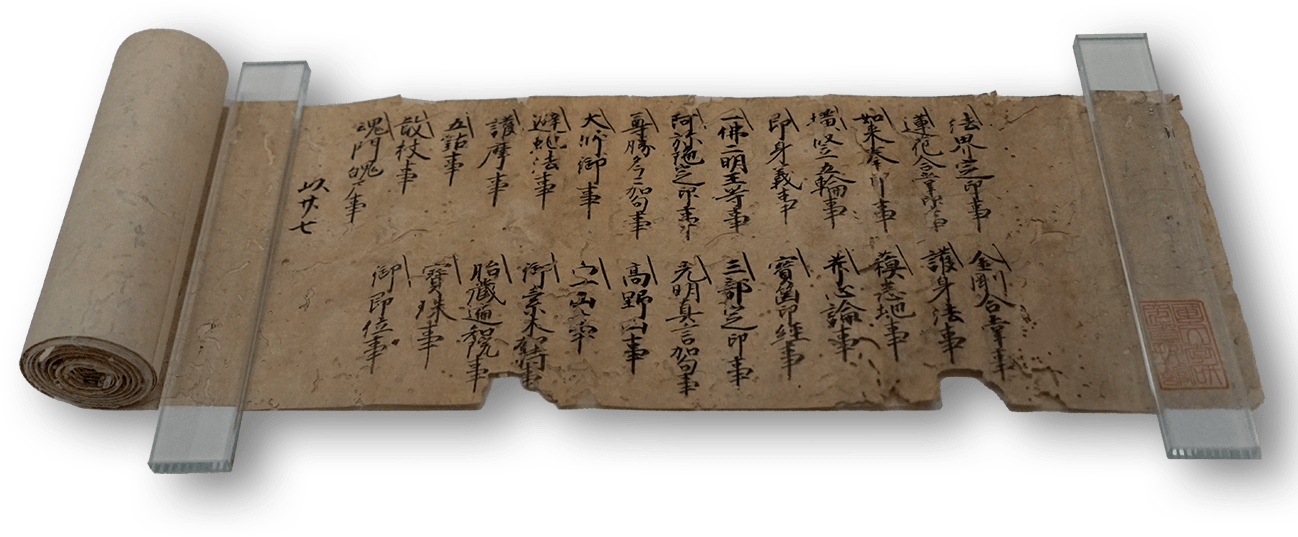
Chibukuro - 智袋
Tsugigami - 継紙
Binding by splicing pieces of paper horizontally and then rolling or folding them. Nomally no stick or cover attached. Sometimes called misō kansubon. Some books, like short ones, are not rolled, but are still included in this category.巻子本に似るが、軸と表紙のないもの。未装巻子本と言うこともある。なお、短いものでは巻いていない場合もあるが、それも含める。
Orihon Group - 折本の類
Binding by splicing pieces of paper horizontally and folding them. Orihon and orijō fall in this category.紙を横に繫げて折り畳んだ装訂で、折本・折帖などがこれに当たります。
Orihon Group - 折本の類
Orihon - 折本
Binding by splicing pieces of paper horizontally and folding them with mountains and valleys made alternately at equal intervals. Unlike orijō, each half of the folding is not made of a single piece of paper, and a joint of paper does not correspond to a fold of paper in general.紙を横に繫げ、等間隔で山折りと谷折りを交互に作って折り畳んだ装訂。折帖と異なり、折の半分がそれぞれ一枚の紙で作られていることはなく、また紙の継ぎ目と折り目も通常は別である。
Orihon Group - 折本の類
Senpūyō - 旋風葉
A method of wrapping the whole of a Orihon book in a single cover across the book's spine, instead of putting separate covers on the front and back(similar to Hōhaisō of Sasshibon). Due to the constraint of the cover, it cannot spread horizontally like orihon and can only be read in a spread-open format.折本の表紙を前後別々に付けず、背をまたいだ一枚の形(冊子本の包背装と同じ)にしたもの。表紙に制約されるため折本のように横に広がらず、見開きの形でしか読めない。
Sasshibon Group - 冊子本の類
Binding by piling up several pieces of paper of same size and sewing up or sticking their sides to each other. This group is further divided into several categories in terms of how paper is used. Unlike kansuban and orihon group, only a spread can be seen at once.紙を複数枚重ね、一方の端を綴じるか糊付けした装訂で、紙の使い方などによりいくつかの種類に分けられます。
Sasshibon Group - 冊子本の類
Decchōsō - 粘葉装
Binding by folding pieces of paper in two, piling them up and sticking them to each other with paste applied at the sides of their outer folds. This binding has existed since the Heian period. Printed books in this binding are almost entirely limited to Buddhist books.紙を二つに折り、外側の折り目の脇を糊代として貼り重ねたもの。平安時代からある装訂。版本の例は、ほぼ仏書に限られる。
Sasshibon Group - 冊子本の類
Recchōsō - 列帖装
Binding by piling up two or more pieces of paper, folding them in two to make a set (called hitokukuri or hitoori), arranging two or more of those sets and sewing them up with strings. This binding has existed since the Heian period. This is mainly used for manuscript books. Some printed books also use this binding, though in limited genre.紙を二枚以上重ねて二つ折りにしたもの(一括り・一折)を複数並べ、糸などで綴じたもの。平安時代からある装訂。主に写本に見られ、版本にもあるが、分野が限られる。
Sasshibon Group - 冊子本の類
Origami Recchōsō - 折紙列帖装
A kind of recchōsō, using origami as ryoshi (for origami, see origamitoji; in some origami recchōsō books, portrait paper sheets are folded in two).列帖装の一種で、料紙に折紙を用いたもの。(折紙については折紙綴を参照。なお折紙列帖装では、縦長の紙を二つ折りにするものもある)
Sasshibon Group - 冊子本の類

Keichō Jūhachinen Hachigatsu Jūgonichi Funanimichi Renga - 慶長十八年八月十五日賦何路連歌
Origamitoji[Tentative Name] - 折紙綴(仮称)
Binding by piling up pieces of origami paper (mainly landscape paper sheets folded in two so that folds come below or half sized ones) and sewing up their right-hand end with string. Seldom used for printed books.折紙(横長の紙を折り目が下になるように二つ折りにしたもの、またはその半截が主)を重ね、右端を糸などで綴じたもの。版本の例は少ない。
Sasshibon Group - 冊子本の類

Kanamoji Zukai - 仮名文字遣
Tan'yōsō - 単葉装
Binding by piling up unfolded pieces of paper and sewing up their right- hand end with string or paper string.折っていない紙を重ね、右端を糸や紙縒などで綴じたもの。
Sasshibon Group - 冊子本の類
Sōyōsō[Tentative Name] - 双葉装(仮称)
Binding by folding pieces of papers in two, piling them up and sewing up the end closer to the fold with string or paper string. While paper is used in the same way as decchōsō, a difference is that paper is not pasted but sewed up with string.紙を二つ折りにしたものを重ね、折り目に近い端を糸や紙縒などで綴じたもの。粘葉装と同じ紙の使い方であるが、糊付けでなく糸などで綴じる点が異なる。
Sasshibon Group - 冊子本の類
Gajōsō - 画帖装
Binding by folding pieces of paper in two and splicing them with paste applied at the opposite end of the outer folds. Used to make a sasshibon book that collects pictures each of which completes by itself. Many books of this type are printed books. Probably invented after the middle Edo period.二つ折りにした紙を、外側の折り目と反対側の端を糊代として貼り繫いだもの。一枚で完結する絵を集めて冊子本にする場合などに用いられる。版本の例が多く、江戸中期以降に考案された装訂か。
Sewing Method of Sasshibon - 冊子本綴じ方
In sewing up a sasshibon book with string or paper string, there are several ways of threading them. Different types of sasshibon are made with different combinations of how to use and sew up paper.冊子本を糸や紙縒などで綴じる場合、その通し方にいくつかの種類があります。紙の使い方と綴じ方の組み合わせによって、各種の冊子本が作られます。
Sewing Method of Sasshibon - 冊子本綴じ方
Musubitoji - 結び綴
Sewing up by making holes, two on each of the upper and lower sides of the right-hand end of a sasshibon book, threading a string or paper string through each hole, and tying it. Mainly used or fukurotoji, origamitoji ,and sōyōsō but some recchōsō examples exist.冊子本の右端に上下各二箇所ずつ穴を開け、それぞれに紙縒や紐などを通し、結んで綴じたもの。
Sewing Method of Sasshibon - 冊子本綴じ方
Yotsumetoji - 四つ目綴
Sewing up by making four holes on the right-hand end of a sasshibon book and threading string through them. Often used for fukurotoji books, but also for tan'yoso and origamitoji.冊子本の右端に四箇所穴を開け、糸を通して綴じたもの。袋綴本によく用いられるが、単葉装・折紙綴などにも見られる。
Sewing Method of Sasshibon - 冊子本綴じ方
Itsutsumetoji - 五つ目綴
Sewing up by making five holes on the right-hand end of a sasshibon book and threading string through them. This is generally considered to be a deluxe edition because it requires one more touch than yotsumetoji.冊子本の右端に五箇所穴を開け、糸を通して綴じたもの。四つ目綴より一手間多くかかり、概して上製本と考えられる。
Sewing Method of Sasshibon - 冊子本綴じ方
Kōkitoji - 康熙綴
Sewing up by making holes between the upper/lower holes and the corners on a yotsumetoji book and threading string through them. It is thought that this incorporated a sewing method that was popular in the Kōki period in Qing (1662–1722) and was used after the middle Edo period for Chinese poem anthrogies or collected pictures.四つ目綴の上下の穴と角の間に穴を開けて糸を通したもの。中国・清の康熙年間(1662-1722)に流行した綴じ方を取り入れたもので、江戸中期以降に用いられた。
Sewing Method of Sasshibon - 冊子本綴じ方
Shiteisō - 紙釘装
Sewing up by making several holes on the right-hand end of a sasshibon book, threading a paper string through each of those holes, cutting it so that it sticks out of the cover a little, and smashing the sticking-out part so that it does not come out. This is called shiteisō or paper-nail binding because the smashed paper string looks like the head of a nail.冊子本の右端に数箇所穴を開けてそれぞれに紙縒を通し、表紙から少し出るようにして切り、出た部分を叩いてつぶし、抜けないようにして綴じたもの。つぶした紙縒の端が釘の頭の形であることから紙釘装と言う。
Sewing Method of Sasshibon - 冊子本綴じ方
Seanatoji[Tentative Name] - 背穴綴(仮称)
Sewing up by making holes on folds of paper at the spine of a sessibon book and threading string through them. Used for recchosō and tanjosō. Generally two holes are made at each of the upper and lower parts, and a string is threaded through those two holes. Rarely used for sōyōsō.背の部分の紙の折り目に穴を開け、糸などを通して綴じたもの。列帖装と単帖装に用いられ、普通は上下に二箇所ずつの穴を開け、二箇所の穴の間にそれぞれ糸を通して行く。双葉装の例も稀にある。
How to Fit the Cover on a Sasshibon Book
- 表紙の付け方
The cover of a sasshibon book is generally separated into the front and back covers, but some books have a single cover going from the front to the back.冊子本の表紙は、通常表表紙と裏表紙に分かれていますが、表から裏にかけて一枚の表紙をかけることがあります。








